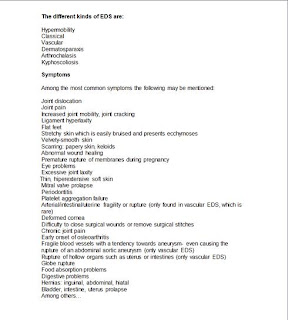 AL FÍN PUDE HACER PASAR LOS FOLLETOS AL INGLÉS !!!
AL FÍN PUDE HACER PASAR LOS FOLLETOS AL INGLÉS !!! EHLERS DANLOS SYNDROME
This Internet site was created in order to help all those who need information and/or guidance about the Ehlers-Danlos Syndrome (EDS), and create a network of links to sites of interest to provide easy access to all kinds of information in a simple and practical way.
All of this information has been compiled and is shared in a blog and in our Facebook page.
The purpose of this site is to connect people and/or organizations at no profit.
Another purpose is to share information so that this syndrome is better known and made visible.
We are working on spreading this information to reach even those who have no Internet access.
Our blog
In our blog we share everything that is known about this syndrome to this day-description, notes and research on treatments, a detailed but simple description of symptoms with understandable medical terms and links to web pages of interest for additional information.
We have a complete file with addresses and links of interest sorted to provide faster search for all kinds of information and easier contact with other Internet sites for consultation at any time:
- Web pages, Facebook and Twitter accounts.
- Data on hospitals and care centers with medical professionals to help those with EDS and geneticists.
- Recommended books and notes.
- News and more…
We are supported by RED DE AMOR (Network of Love), and connected with SED66 (France) with whom we will be working together starting this year.
What is the Ehlers Danlos Syndrome?
It is the name given to a group of inherited connective tissue disorders. A series of genetic anomalies causes problems in the synthesis of collagen in the body. This is due to defects in the enzymes that synthesize collagen, a protein that acts as “glue” for the bodies of people and animals.
Collagen keeps all tissues together, provides structure and strength to skin, bone tissue, blood vessels and organs.
Depending on the individual mutation, the severity of the syndrome can vary from mild to life-threatening.
The different kinds of EDS are:
Hypermobility
Classical
Vascular
Dermatosparaxis
Arthrochalasis
Kyphoscoliosis
Symptoms
Among the most common symptoms the following may be mentioned:
Joint dislocation
Joint pain
Increased joint mobility, joint cracking
Ligament hyperlaxity
Flat feet
Stretchy skin which is easily bruised and presents ecchymoses
Velvety-smooth skin
Scarring: papery skin, keloids
Abnormal wound healing
Premature rupture of membranes during pregnancy
Eye problems
Excessive joint laxity
Thin, hiperextensive soft skin
Mitral valve prolapse
Periodontitis
Platelet aggregation failure
Arterial/intestinal/uterine fragility or rupture (only found in vascular EDS, which is rare)
Deformed cornea
Difficulty to close surgical wounds or remove surgical stitches
Chronic joint pain
Early onset of osteoarthritis
Fragile blood vessels with a tendency towards aneurysm- even causing the rupture of an abdominal aortic aneurysm (only vascular EDS)
Rupture of hollow organs such as uterus or intestines (only vascular EDS)
Globe rupture
Food absorption problems
Digestive problems
Hernias: inguinal, abdominal, hiatal
Bladder, intestine, uterus prolapse
Among others…
Not all of these symptoms are always present. Some people present some symptoms and not others.
The Ehlers-Danlos Syndrome is an incurable disease which may cause paralysis and is hereditary. Therefore, all these problems and symptoms must be treated as they appear. Prospective parents need to seek genetic advice. The usual procedure is to search for symptoms, a compatible family history, and the collagen defect is usually tested on a small sample of ski



No hay comentarios:
Publicar un comentario